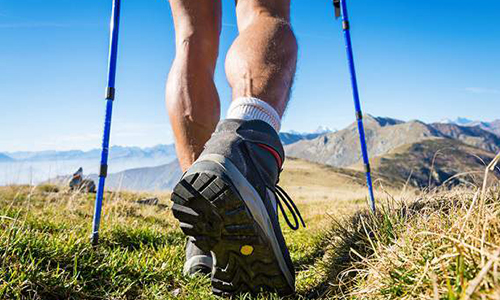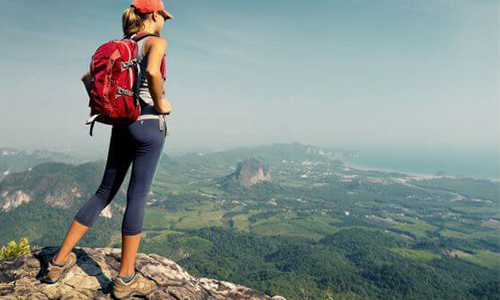Running Shoes over Boots for Hiking
Author

Chris shares his passion for cycling, hiking, skiing, and climbing from Buxton, in the Peak District. As a blogger for Outdoor Look, Chris shares outdoor tips and indoor tricks to help you get the most out of your time spent outside. When he's not out adventuring he's making videos or trying to keep up with his 4-year-old son.
 Whenever it comes to hiking up the hills we cannot afford to ignore the comfort of smart and comfortable footwear. Going by the trends, hiking boots are what are most popular amongst the hikers. We have been constantly told that boots are essential to experience the best of hiking. One looks for great ankle support, toughness, and water protection in the hiking footwear. With years of experience in hiking, my friend Brad once told me that shoes are far better than boots for most hiking scenarios.
Whenever it comes to hiking up the hills we cannot afford to ignore the comfort of smart and comfortable footwear. Going by the trends, hiking boots are what are most popular amongst the hikers. We have been constantly told that boots are essential to experience the best of hiking. One looks for great ankle support, toughness, and water protection in the hiking footwear. With years of experience in hiking, my friend Brad once told me that shoes are far better than boots for most hiking scenarios.
Someone who has been an ardent supporter of boots might have a biased opinion about hiking boots. However, my personal experience makes me believe that one should never go with what is said, but first try it and then praise the same. With years of trailing experiences, I have come to the conclusion that ditching your hiking boots is for the best. Having said this, I do not want to discourage the lot, that have had good and happy experiences with their hiking boots. If that is what keeps you contented then go for them! My taste in hiking footwear though, has now shifted from boots to simple yet performance-friendly running shoes. Let us look at a few points that uprooted my belief in old-school footwear for hiking.
Waterproof
Do you own those waterproof boots? Thinking that these might keep your feet dry? Believe me, they will not. All you will be left with will be feet with sweat. Hiking in rainy weather can end up leaving your feet damp. This might lead to blisters. Rather, pick up breathable shoes that keep your feet dry throughout the day. These dry easily too, as compared to waterproof boots.
Come what may, waterproof boots have a tendency of developing holes over time, that then easily let the rain water creep in. It becomes inevitable for the feet to get wet during prolonged rains. This leads to unnecessary heaviness and weight of the boots. Besides, the boots take a longer time to dry.
Blisters
Mostly boots feature hard soles. The rigidness of the boots can hinder the flexibility of the shoes. On top of that, if by any chance your boots have some tiny holes, then your feet are more vulnerable to blisters. Blisters are the last thing you would want while you are on a hike. Hence, avoiding these boots is a wise thing to do.
Weighty Affair
 Who loves to hold on to things that are heavy and require double your efforts to pay off? Even wearing footwear that are heavy can take a toll on you. Carrying more weight means spending more energy. Running shoes on the other hand can significantly cut down the weight, leading to conservation of energy. Also, wearing heavy boots can lead to unwanted fatigue. This might unintentionally be an invitation to uncalled injuries too.
Who loves to hold on to things that are heavy and require double your efforts to pay off? Even wearing footwear that are heavy can take a toll on you. Carrying more weight means spending more energy. Running shoes on the other hand can significantly cut down the weight, leading to conservation of energy. Also, wearing heavy boots can lead to unwanted fatigue. This might unintentionally be an invitation to uncalled injuries too.
Ankle Support and Safety
Shoe brands are often seen emphasising on the ankle support factor. Honestly speaking, ankle support is nothing but a myth when it comes to shoes. It has been drilled into our heads that ankle support can help us from injuries while hiking. However, there is not much fact and evidence to support this.
Often it comes to hearing that strengthening and stretching ankles can prevent ankle injuries. Boots usually leave you tired and wearied. This can definitely make you prone to a lot of injuries. Boots are usually stiff and hardly flexible.
Cost a Bomb
Buying boots mean investing a huge amount. It is no less than burning a hole in your pocket. Moreover, if you are a frequent hiker, buying boots can be a risky task. Right from maintaining them to using them, boots can lead to a lot of hassle and unnecessary energy consumption.
If boots are your thing, then I am no one to judge you. However, after hiking 2,650-miles in running shoes, I would never switch back to boots. Choosing lightweight running shoes can be the ideal thing to do. Opting for good traction and a soft and flexible sole can definitely save you from painful and sore feet. Hiking is more fun when you know what suites you the best.
Author

Chris shares his passion for cycling, hiking, skiing, and climbing from Buxton, in the Peak District. As a blogger for Outdoor Look, Chris shares outdoor tips and indoor tricks to help you get the most out of your time spent outside. When he's not out adventuring he's making videos or trying to keep up with his 4-year-old son.
- Speed Up Your Post-Hike Recovery with These 6 Essential Tips
- Cycling through Tranquil Roads and Coastal Views on the Isle of Wight
- The Essential Guide to Hiking Safety: 5 Tips Every Hiker Should Know
- Run Smart, Run Strong: Your Guide to Injury-Free Running
- Embrace Biking: Essential Tips for Beginners
Categories
- Sport (28)
- Product Reviews (3)
- Team Outdoor Look (7)
- Mike Wild (2)
- Mike Payton (2)
- Suse Hammond-Pears (3)
- Snowboarding (12)
- Latest Offers (105)
- Shop Talk (1)
- Competitions (7)
- Walking (413)
- Lifestyle Fashion (8)
- Travel (86)
- Kit Guides (176)
- Workwear Clothing (6)
- Safety Workwear (4)
- Health/Fitness (289)
- Skiing (91)
- Great Outdoors (1316)
- Cycling (92)
- January 2025
- December 2024
- November 2024
- October 2024
- September 2024
- August 2024
- July 2024
- June 2024
- May 2024
- April 2024
- March 2024
- February 2024
- January 2024
- December 2023
- November 2023
- October 2023
- September 2023
- August 2023
- July 2023
- June 2023
- May 2023
- April 2023
- March 2023
- February 2023
- January 2023
- December 2022
- November 2022
- October 2022
- September 2022
- August 2022
- July 2022
- June 2022
- May 2022
- April 2022
- March 2022
- February 2022
- January 2022
- December 2021
- November 2021
- October 2021
- September 2021
- August 2021
- July 2021
- June 2021
- May 2021
- April 2021
- March 2021
- February 2021
- January 2021
- December 2020
- November 2020
- October 2020
- September 2020
- August 2020
- July 2020
- June 2020
- May 2020
- April 2020
- March 2020
- February 2020
- January 2020
- December 2019
- November 2019
- October 2019
- September 2019
- August 2019
- July 2019
- June 2019
- May 2019
- April 2019
- March 2019
- February 2019
- January 2019
- December 2018
- November 2018
- October 2018
- September 2018
- August 2018
- July 2018
- June 2018
- May 2018
- April 2018
- March 2018
- February 2018
- January 2018
- December 2017
- November 2017
- October 2017
- September 2017
- August 2017
- July 2017
- June 2017
- May 2017
- April 2017
- March 2017
- February 2017
- January 2017
- December 2016
- November 2016
- October 2016
- September 2016
- August 2016
- July 2016
- June 2016
- May 2016
- April 2016
- March 2016
- February 2016
- January 2016
- December 2015
- November 2015
- October 2015
- September 2015
- August 2015
- July 2015
- June 2015
- May 2015
- April 2015
- March 2015
- February 2015
- January 2015
- December 2014
- November 2014
- October 2014
- September 2014
- August 2014
- July 2014
- June 2014
- May 2014
- April 2014
- March 2014
- February 2014
- January 2014
- December 2013
- November 2013
- October 2013
- September 2013
- August 2013
- July 2013
- June 2013
- May 2013
- April 2013
- March 2013
- February 2013
- January 2013
- December 2012
- November 2012
- October 2012
- September 2012
- August 2012
- July 2012
- June 2012
- May 2012
- April 2012
- March 2012
- February 2012
- January 2012
- December 2011
- November 2011
- October 2011
- September 2011
- August 2011
- May 2010
- April 2010
- March 2010
- February 2010
- January 2010
- November 2009
- October 2009
- September 2009
Submit a Comment